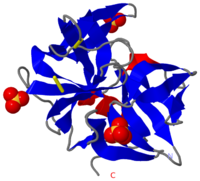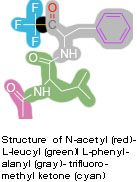
Crystal Structure of
Cellulomonas Bogoriensis Chymotrypsin
2ea3 Function
Chymotrypsin (Chy or α-Chy) is a digestive enzyme containing an active serine residue, which helps to digest proteins in our food. Other related proteases are crucial for blood clotting (thrombin and other proteases), for the AIDS virus metabolism (HIV protease) and for many other processes relevant to human health and agriculture. Chymotrypsin cleaves peptide bonds of proteins where the amide side of the bond is an aromatic amino acid like tyrosine, phenylalanine or tryptophan. Bovine Chy is found in 2 forms: A and B. The 2 forms have different proteolytic characteristics. The image at the left is the crystal structure of chymotrypsin from Cellulomonas Bogoriensis (2ea3) with sulfate ions.[1]
- γ-Chy is a covalent acyl adduct of α-Chy.
- Chymotrypsinogen is nonactive precursor of α-Chy. It is converted to the active form, i.e., chymotrypsin by trypsin.
Some additional details in
Overview
While chymotrypsin occurs in many organisms, the most-studied chymotrypsin is that from cows (bovine chymotrypsin), shown here with an inhibitor molecule (shown in CPK-colored ball and stick) bound to the active site (). It is synthesized as a single polypeptide chain of 245 amino acids, called chymotrypsinogen, which is inactive. The enzyme is activated by one cleavage by trypsin and two cleavages by chymotrypsin (autolytic cleavages) that result in the loss of four amino acids from the remaining three polypeptides, which are shown here in turquoise, beige, and violet. These three chains are held together by . The bonded cysteine residues are shown in space fill with yellow sulfur atoms. There also three . Here chymotrypsin is shown in cartoon with pink α-helices and yellow β-strands, and this shows that it is mainly composed of .
Substrate-binding and Active Sites
Features of the substrate-binding and active sites can be seen in the structure of bovine chymotrypsin bound to the inhibitor N-acetyl-L-leucyl-L-phenylalanyl trifuoromethyl ketone, which resembles a peptide substrate (see structure in left figure). The colored backgrounds in the figure indicate the four components of structure and shows the bond (yellow on black background) that is position to be cleaved.
Here is chymotrypsin (space fill) with the inhibitor (CPK ball & stick) showing the . Note the active site is in a depression on the surface of the enzyme. Chymotrypsin contains three residues, Ser 195, His 57 and Asp 102, which are known as its , shown in CPK ball and stick in this close up of the active site. Similar three-dimensional arrangements of a serine, a histidine and an aspartate are observed in many other proteases, and the role of these three residues in catalysis has been studied extensively. Serine acts as a nucleophile (contributing the electron pair for a new bond) attacking the carbonyl carbon of the peptide bond to be hydrolyzed. Histidine and aspartate turn serine into a better nucleophile by assisting in removing a hydrogen ion from serine.
The , can be seen in this view with the inhibitor in light gray ball & stick with its phenyl group in orchid. By moving the structure back and forth with your mouse, it is easy to see that the phenyl group is located in the hydrophobic binding pocket of the enzyme. This binding pocket determines the enzyme's preference for cleavage of peptides on the C-terminal side of aromatic residues.
This view shows the in CPK colors. The triflouromethyl group is bound to the carbonyl carbon via the yellow bond. In a peptide substrate, the triflouromethyl group would be replaced by the first amino acid residue of the rest of the peptide chain, and the yellow bond would be the bond that is cleaved. The carbonyl carbon of the inhibitor is 1.52 Å away from the side chain oxygen of serine 195, and this indicates they are covalently bound (bond indicated by dotted line). Thus, this structure is similar to the tetrahedral intermediate that is formed during the cleavage reaction. The negative charge that develops on the carbonyl oxygen of the substrate is stabilized by hydrogen bonds to the backbone nitrogens of Ser 195 and Gly 193, shown in blue spacefill. The hydrogen atoms involved in these hydrogen bonds are not shown.


